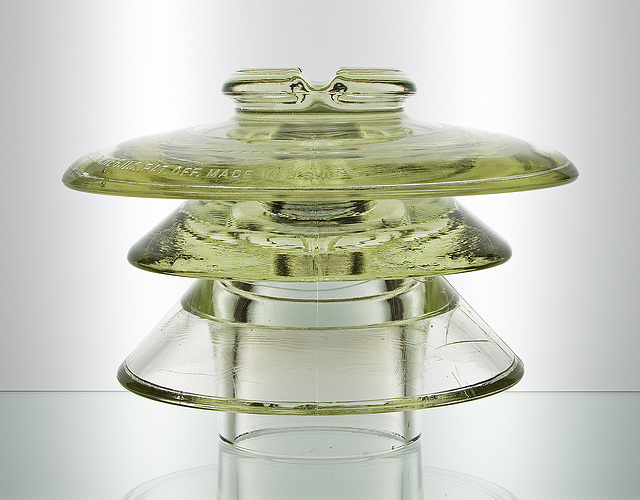See also...
Keywords
Authorizations, license
-
Visible by: Everyone -
All rights reserved
-
1 387 visits
CD 331, PYREX, Yellow Tint


A very large power insulator produced by the Corning Glass Works in Corning, New York for the Pyrex trademark line of insulators which produced insulators in the 1920's - 1940's.
The CD 331 Pyrex insulator with a width of 15" and height of 11" and weight of 38.25 lbs makes it the largest and heaviest glass pintype insulator produced in North America. This Pyrex insulator known as mold style No. 701 were produced in the 1930's and supported voltages of 70,000 volts.
Most CD 331s were used around Dalles & Pendleton, Oregon; Walla Walla & Dayton, Washington; Montana.
Here is a link showing them in service use. Photos by Bill Rohde.
www.insulators.info/service/pyrex.htm
The CD 331 Pyrex insulator with a width of 15" and height of 11" and weight of 38.25 lbs makes it the largest and heaviest glass pintype insulator produced in North America. This Pyrex insulator known as mold style No. 701 were produced in the 1930's and supported voltages of 70,000 volts.
Most CD 331s were used around Dalles & Pendleton, Oregon; Walla Walla & Dayton, Washington; Montana.
Here is a link showing them in service use. Photos by Bill Rohde.
www.insulators.info/service/pyrex.htm
AstroElectric, Lewis Perkins, SW Ohio Lines and 2 other people have particularly liked this photo
- Keyboard shortcuts:
Jump to top
RSS feed- Latest comments - Subscribe to the comment feeds of this photo
- ipernity © 2007-2024
- Help & Contact
|
Club news
|
About ipernity
|
History |
ipernity Club & Prices |
Guide of good conduct
Donate | Group guidelines | Privacy policy | Terms of use | Statutes | In memoria -
Facebook
Twitter

David Dahle has replied to Power LinesMatt Weldon has replied to Power LinesThis is the new piece of glass I purchased so I could photograph all my power pieces individually. It was very difficult laying this big heavy insulator down on the glass, and man I was very nervous about it setting there on the glass even though it was thick glass.
I did a little photographing of a couple insulators for reference purposes a while ago on the cheap. My setup consisted of a cardboard box and a couple sheets of white paper. It did ok, but neither the setup nor the insulators held a candle to what you're doing now!
Matt Weldon has replied to Power LinesThere are pros and cons to using backlighting to photograph your insulators. The pros are you don't get the hotspots or glare from the sun or flash. I always use my tripod and no flash. The cons are you get more of a flat look to the image or less of a three dimensional look compare if you were to photograph outside or use flash.
In the processing the shadow highlight tool in photoshop comes in very handy to bring back the details in the dark areas and to cut down on the glare on the sides of the insulators, especially on the darker insulators.
Some people like the reflection in the glass and some don't. I personally like the reflection because it gives the insulator and image more of a natural look compare to a floating insulator surrounded by white.
Hope this helps out some for anyone getting involved in photographing their insulators.
Here was my setup for photographing my power insulators.
www.flickr.com/photos/mtr736/11974444153
Sign-in to write a comment.